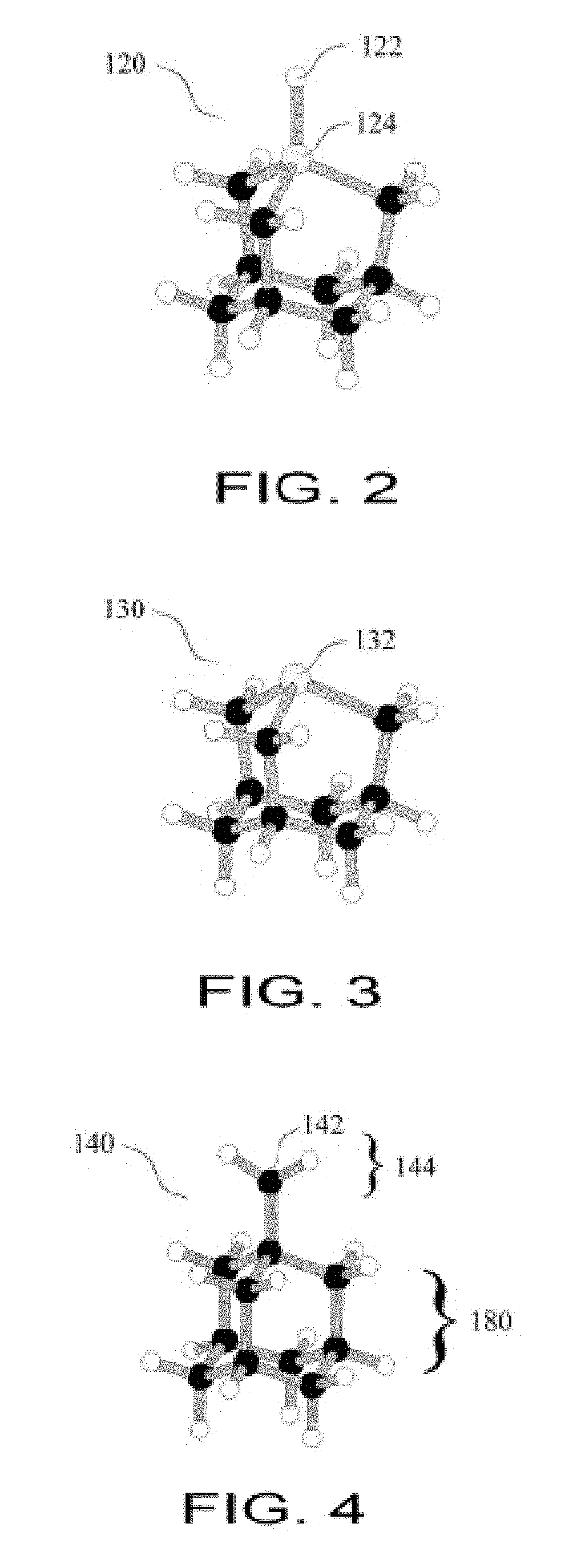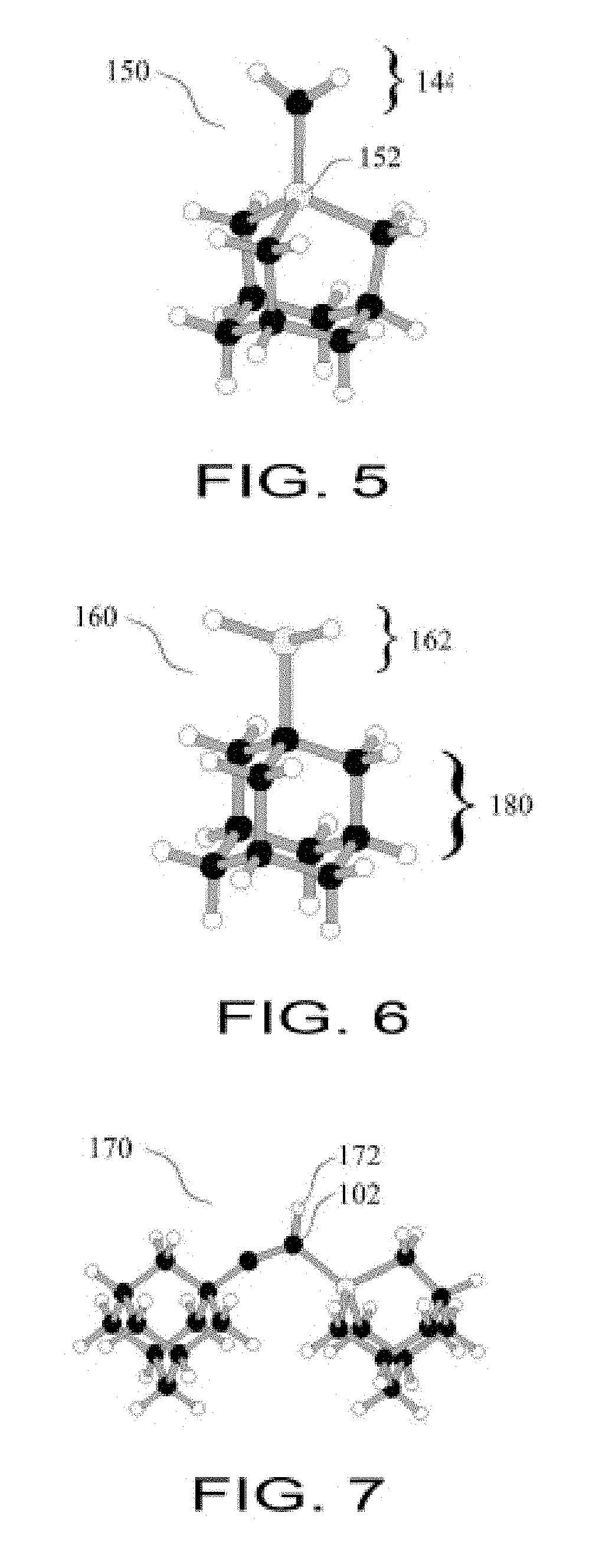However, even on powerful computers, simulating large numbers of atoms at high levels of theory, and potentially using multi-scale techniques (e.g., ONIOM), multiple algorithms to “sanity check” results, and large basis sets, can be extremely computationally-demanding.
However, an entire mechanosynthetic system need not be simulated at a high level of detail.
For example, even when a microscope has the requisite accuracy over short distances, it is possible that the accuracy degrades over longer distances.
However, this work tends to treat mechanosynthesis as a laboratory curiosity rather than attempting to address the issues inherent in creating a viable manufacturing technology.
For example, the experimental literature is generally limited to decorating or modifying surfaces, and limited to small numbers of reactions.
Further, in many previous examples of mechanosynthesis, there is a lack of separation of feedstock, presentation surface and workpiece (the presentation surface often serves as all three).
The computational literature contains other limitations.
This severely limits the versatility of the workpieces that can be manufactured, constraining the elements used in reactions and the nature of the workpieces to which they are applied.
However, each of these references suffers from important limitations in terms of being able to actually manufacture a workpiece via mechanosynthesis (which is not a criticism per se; this was not the intent behind these investigations).
Such limitations include insufficient simulation detail or accuracy (e.g., not describing the computations in a manner that makes them reproducible, or using unrealistically-low levels of theory which cannot be assumed to provide reliable results), lack of a bootstrap sequence, lack of a comprehensive set of reactions and tips, lack of workpiece build sequences (or the means to create them), and others.
They do not teach a generalizable way of creating atomically-precise workpieces.
However, the disclosed tip is limited to a very specific structure (a triadamantane base molecule with a dimer holder atom), performs only a single reaction (dimer deposition), and is constrained to working on a very specific surface (“having a melting point of at least 300° C., a thermal expansion coefficient maximally different than that of diamond, a mismatch in crystal lattice constant as compared to that of diamond, resistance to carbide formation, less bonding strength to the carbon dimer as compared to bonding strength between the diamond holder atom X and the carbon dimer, and little or no solubility or reaction with carbon.”) This work does not teach a versatile or generalizable system of mechanosynthesis.
Although various possibilities are discussed as to implementing such tips, there is little detail and no clear pathway to construction.
Among other drawbacks, none of the tools described in the literature, alone or in combination, could provide a bootstrap process, a set of tools exhibiting closure (that is, a set of tools that could build themselves), a versatile set of reactions, a set of reactions of known reliability at particular temperatures, nor were they directed to a system for three-dimensional fabrication.
In addition to the limitations which may be created by conflating the feedstock, feedstock depot, and workpiece, particularly when the presentation surface is, for example, pure Si or pure Ge (thus limiting the workpiece to a single element), filling a void with a single atom is obviously not the same process as constructing a complex workpiece.
The literature does not teach how to extend mechanosynthetically-created workpieces into three dimensions.
The mechanosynthesis literature generally does not address the issue of designing for reaction reliability.
Even where modeling is performed in the literature, modeling of an atomically-imprecise tip is unlikely to accurately represent the actual experimental system due to lack of knowledge of the exact structure of the tip.
Regardless of the terminology used, work using imprecisely-defined building blocks is not an appropriate parallel to positioning, and making or breaking bonds, with atomic precision.
Clearly, mechanosynthesis cannot, at least in a planned manner that results in an atomically-precise workpiece, be performed using workpiece or feedstock structures in which the location of the constituent atoms is unknown.
However, other such methods, not being able to create a wide range of atomically-precise structures, generally do not result in the same products.
However, such materials, being the result of stochastic processes rather than individually-placed atoms, generally contain impurities, vacancies, incorrectly bonded atoms (e.g., sp2 versus sp3 hybridized carbon in the case of diamond), and random grain boundaries or overall product boundaries.
Most atomically-precise, non-periodic structures would be impossible to create using stochastic techniques.
Additionally, the experimental mechanosynthetic reactions found in the literature have not been engineered in advance for versatility or reliability.
Another drawback of the literature is that the presentation surface also frequently serves as the feedstock depot, feedstock and workpiece, such as with the “vertical manipulation” literature, of which (Oyabu, Custance et al., “Mechanical vertical manipulation of selected single atoms by soft nanoindentation using near contact atomic force microscopy,” Phys. Rev. Lett., 17, 2003; Oyabu, Custance et al., “Mechanical Vertical Manipulation of Single Atoms on the Ge(111)-c(2×8) Surface by Noncontact Atomic Force Microscopy,” Seventh International Conference on non-contact Atomic Force Microscopy, Seattle, Wash., 2004) are representative.
Without more separation of the presentation surface, feedstock and workpiece, the ability to create diverse structures can be limited.
Drawbacks are also created by the use of non-atomically-precise tips in the literature, and in some cases, unrealistically-low levels of theory in computational simulations.
Further, the literature contains no teachings as to how one might generalize the mechanosynthetic techniques presented to other elements and reactions, or to construct complex, three-dimensional workpieces.
 Login to View More
Login to View More 


